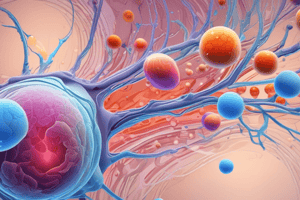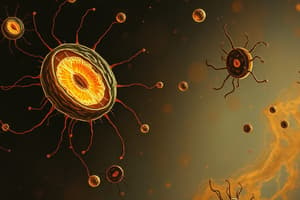Podcast
Questions and Answers
What is the outcome of asymmetric cell division?
What is the outcome of asymmetric cell division?
- Two daughter cells may differ in size, shape, protein composition, and gene expression (correct)
- Two daughter cells are both different from the parent cell and from each other
- Two daughter cells are both identical to the parent cell
- Two daughter cells are identical to each other and to the parent cell
What characterizes symmetric cell division?
What characterizes symmetric cell division?
- Two daughter cells are both identical to the parent cell
- Two daughter cells are identical to each other and to the parent cell (correct)
- Two daughter cells are both different from the parent cell and from each other
- Two daughter cells may differ in size, shape, protein composition, and gene expression
What does cell lineage tracing enable?
What does cell lineage tracing enable?
- Labeling cells to identify their origin
- Maintaining the stem cell population
- Producing differentiated cells
- Tracing the birth order of cells progressively becoming more restricted in developmental potential (correct)
Which factors are part of the basic transcriptional network regulating the pluripotency of embryonic stem cells?
Which factors are part of the basic transcriptional network regulating the pluripotency of embryonic stem cells?
Which cells can induced pluripotent stem cells (iPSCs) be derived from?
Which cells can induced pluripotent stem cells (iPSCs) be derived from?
What can patient-specific iPSCs be used for?
What can patient-specific iPSCs be used for?
What do morphogen gradients help establish in cells, tissues, and organs?
What do morphogen gradients help establish in cells, tissues, and organs?
Which morphogen is essential for the normal regeneration of head and tail by planaria?
Which morphogen is essential for the normal regeneration of head and tail by planaria?
What does Sonic hedgehog (Shh) protein polarize during development?
What does Sonic hedgehog (Shh) protein polarize during development?
What genes are involved in the genetic logic of development in Drosophila melanogaster?
What genes are involved in the genetic logic of development in Drosophila melanogaster?
What is involved in the enhancer modularity and function in the even-skipped (eve) gene of Drosophila melanogaster?
What is involved in the enhancer modularity and function in the even-skipped (eve) gene of Drosophila melanogaster?
What is crucial for the development of segmental identities in the embryo of Drosophila melanogaster?
What is crucial for the development of segmental identities in the embryo of Drosophila melanogaster?
Flashcards are hidden until you start studying
Study Notes
Cellular Stemness and Signaling Pathways in Development
- Hematopoietic stem cells from human bone marrow can divide to produce more HSCs or become different progenitor and differentiated cell types.
- The basic transcriptional network regulating the pluripotency of embryonic stem cells involves multiple factors including 5 master TFs: Klf4, Myc, Nanog, Sox2, Oct4.
- Induced pluripotent stem cells (iPSCs) can be derived from somatic cells of patients with difficult diseases such as ALS and can give rise to progeny of all 3 germ layers.
- Patient-specific iPSCs can be used for gene targeting, gene correction, and direct differentiation into affected neuronal subtypes for medical applications.
- Two major cell signaling pathways are controlled by morphogens, which induce different cell fates depending on their concentration at target cells.
- Morphogen gradients help establish cell differentiation, body axes, orientation, and patterning of tissues and organs by specifying uniform cells into 3 cell types.
- Gradients of Wnt, a morphogen, are essential for the normal regeneration of head and tail by planaria, and its inhibition can result in abnormal regeneration.
- Sonic hedgehog (Shh) protein, another morphogen, polarizes developing limbs and its inhibition can lead to abnormal development, as seen in a cycloptic lamb.
- The model of Drosophila melanogaster anterior-posterior axis formation provides evidence of the genetic logic of development, involving maternal exis determination genes, gap genes, pair rule genes, and segment polarity genes.
- Enhancer modularity and function in the even-skipped (eve) gene of Drosophila melanogaster involves specific promoter regions and competitive interactions between activators and repressors.
- Hox gene expression and function in Drosophila melanogaster is crucial for the development of segmental identities in the embryo, as depicted in the expression map of hox genes.
- The text discusses the regulation of cell division and differentiation, the transcriptional network regulating pluripotency, the derivation and medical applications of induced pluripotent stem cells, the control and effects of morphogens, and the genetic logic of development in Drosophila melanogaster.
Studying That Suits You
Use AI to generate personalized quizzes and flashcards to suit your learning preferences.




